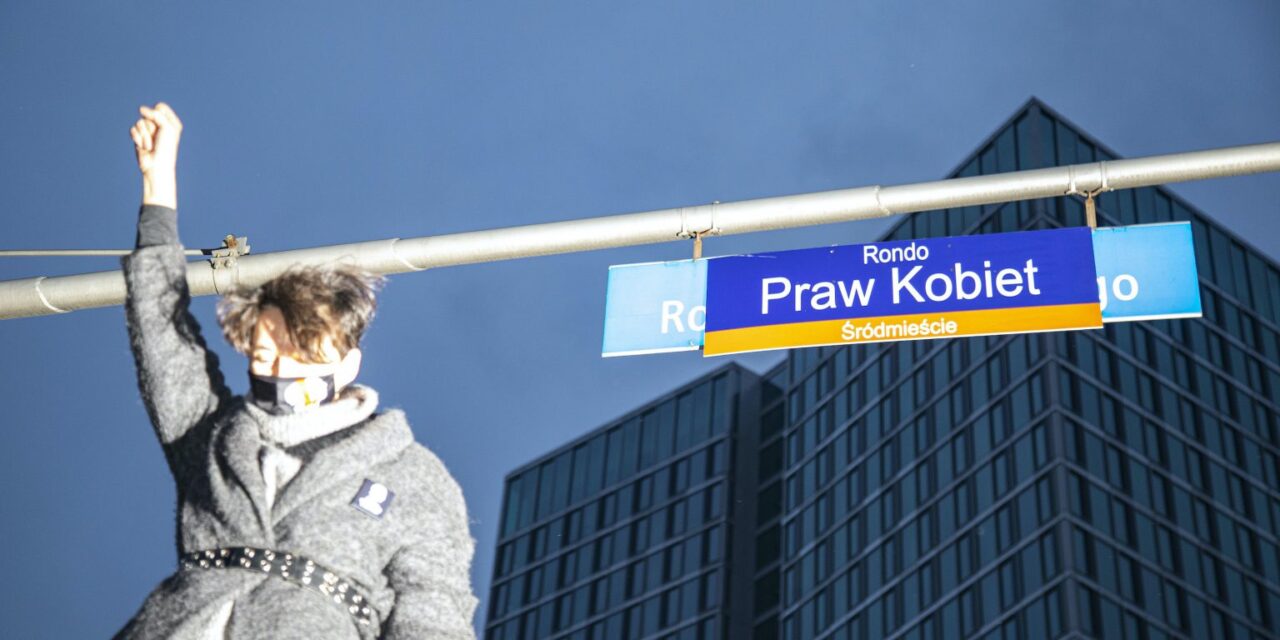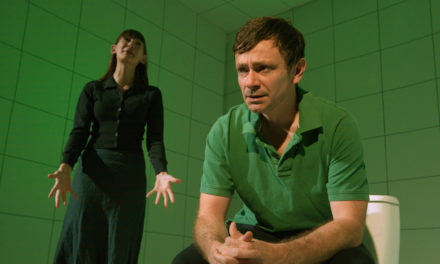Artist Szymon Adamczak moves between the Netherlands and his home country Poland. Since the outbreak of Covid-19 more than a year ago, he has witnessed how a broad mix of Polish citizens – artists, activists, social workers, youngsters, and families – are taking to the streets, protesting and working in public space with a new-found urgency. The political pressure of anti-democratic far-right ideology is greater than ever, but so is the people’s determination as they cry out: get the fuck out!
End of February 2020. I am in Warsaw for a long-awaited roundtable conversation on HIV activism and intersectional solidarity in a local context. Unlike some Western countries, the Polish response to the problem of HIV has been disconnected from social movements and affected communities at large. The meeting takes place in Biennale Warszawa, an interdisciplinary public institution interested in fostering reflection on civic society and education in the public sphere. It is typical in Poland governed by the Law and Justice party, that some cultural institutions become hubs for addressing issues that are uncomfortable, overlooked, if not entirely disregarded by politicians, such as HIV, workers’ rights, climate issues, and equality matters, among others.
The HIV epidemic in Poland in the long 1990s bore the hallmarks of abject fear-mongering by the media. Arguably, the most repulsive figure presented by the media was the drug addict threatening “normal people” in public with an infected needle. In this atmosphere, the world shut out people who were deemed vectors of the disease. Many died anonymously and those who survived were at the mercy of the system. This HIV-related phobia was politically convenient, as the majority saw themselves represented in the media as safe from the virus. The problem was extrapolated onto the already marginalized, who could not speak on their own terms, nor claim any political agency.
Here, it is worth reminding ourselves that systemic homophobia is a legacy of the communist period when the accusation of being a ‘homosexual’ could effectively break one’s career. Fear of HIV was used as justification for launching the infamous “Hyacinth” action, a secret police mass surveillance campaign (1985-1987) intended to create a national database of gay people, one of the “high-risk” groups for HIV. As a result, people began to conceal their sexuality even more carefully; this process, I believe, will only start to reverse on a larger scale as younger generations enjoy greater freedoms afforded by post-transformation democracy. It is not a coincidence that the struggle for equality and for personal freedom, obvious freedom such as women deciding about their own bodies in the context of reproductive rights[1]In 1993 access to legal abortion became limited despite mass protests and against the women rights organizations., has been accelerating in the course of the coronavirus pandemic. These issues were boiling up in society since the 1990s, and once the grip of populist government started to feel tighter, people reacted on an unprecedented scale.
NATIONAL QUARANTINE
As I am flying back two days after the roundtable meeting to Amsterdam with an impromptu mask on my face, I feel relieved that I am able to escape right before the announced closure of the borders. It is to be expected that the chaos and uncertainty of the early days of the pandemic will be felt differently in Poland than in the Netherlands. Polish Prime Minister Morawiecki calls the first lockdown “national quarantine,” whereas Mark Rutte dubs it the “1,5-meter society.” Polish populist government seemingly does not deliver in providing wide access to tests, imposes strict rules on access to public spaces, virtually locking people up at home, while arguing in defense of an already underperforming healthcare system. It is worth noting that people in Poland are showing a lot of solidarity to one another in the situation: artists are printing 3D components of missing equipment for respirators, and a Facebook group called Visible Hand is amassing thousands to “help thy neighbor in need.”
Another reason for my sense of relief has to do with the precarity of working in the cultural/artistic sector. In the end, as a self-employed artist in the Netherlands, I am able to receive financial support from the municipality, and I can supplement my income as a cleaner on the side. My peers in Poland lack access to medical insurance, and while a few can pursue a freelance income comparable to the Netherlands, side jobs are dramatically underpaid and evaporating as we speak. The Ministry of Culture has offered support, but it is hardly sufficient. Interestingly, the pandemic has reinvigorated a long-overdue debate on social benefits for the arts sector and on general standards in terms of wages. Public institutions have organized debates on the gig economy and overproduction, some theatres and museums have decided to cancel their programs and redistribute funding, especially through micro-commissions and streamed events.
CARDBOARD ACTIVISM
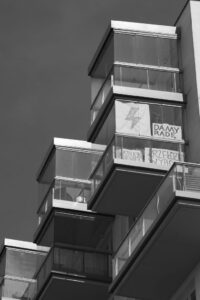
“Cardboard activism” of Warsaw-based artist Paweł Żukowski
Perhaps the early pandemic atmosphere is best exemplified by the ‘cardboard activism’ of Warsaw-based artist Paweł Żukowski. In the past, he committed himself to be responsive to the absurd malfunctions of democracy under the rule of the Law and Justice party. His voice is a queer one, unreserved and unapologetic. “I keep lying to people about myself,” “We’ve never been in fear as much as we are now,” “The longer it lasts, the more I play with my kittens.” It speaks frantically at times as it expresses its desires and feelings spontaneously. Cardboard placards that first started as one-person protests during corona eventually spread through the city: on the balconies of friends, in the windows of art institutions, on Instagram feeds buzzing like never before. Some of them are giving people the message of hope, “we’ll get by,” others state a simple, popular demand: “we want tests.” The DIY format proposed by Zukowski has proven to be effective in evoking a sense of shared consciousness and, accessible as ever, it has been picked up by many hands. Funnily enough, the artist snapped in an interview that he is a “40 year old fag with no social authority whatsoever.” I think that the sincerity of his approach, the nerve as well as the precarity of the cardboard material, which is perhaps reminiscent of the arte povera style, utilizes well the endless flow of image-production on social media and sublimates the momentum, expressing what needs to be voiced.
“In an increasingly polarized country, the red lightning bolt allows for instant identification, serving as a symbol of shared rage, denoting strength, change and victory to come.”
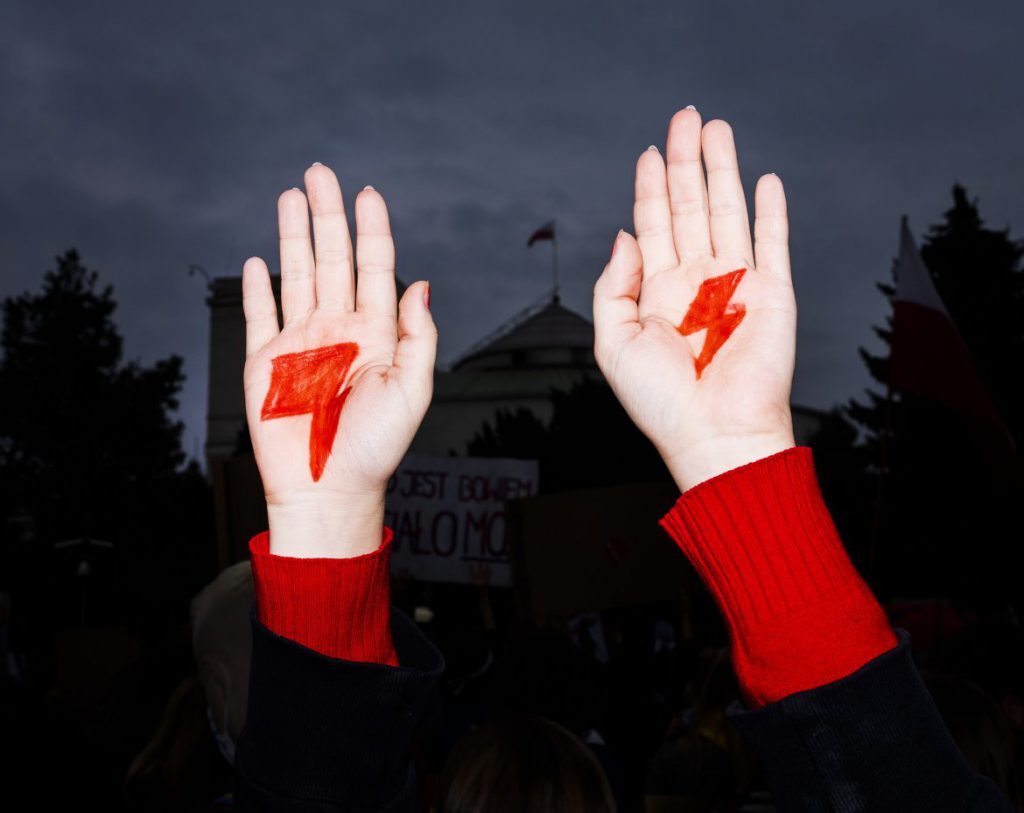
Warszawa 28.10.2020 © Rafal Milach / Archive of Public Posts
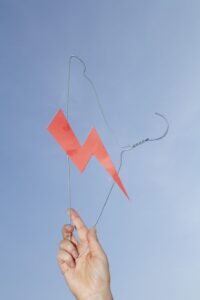
Kraków, 28.10.2020 Joanna Helena / Archive of Public Posts
In early April 2020, the government proposed a set of regulations and economic packages in response to the challenges posed by the pandemic. Simultaneously politicians introduced unrealistically high penalties for breaking quarantine (from 5,000 to 30,000 zlotys = 1,200 to 6,500 euros) and all of a sudden they increased the number of years in prison for people convicted for exposing others to HIV transmission. Policing pandemics in such a manner signals a frail state, one that chooses to impose force and power over life. Instead of being authoritative, it becomes authoritarian. Soon after a first reading of the anti-abortion bill took place in the parliament. Women Strike responded fast with protests utilizing bikes and cars to block the streets. The iconic lightning bolt designed by Ola Jasionowska started to appear basically everywhere, including in digital classrooms as students and pupils started to fight back against the traditional values heavily imposed on their education[2]Numerous students faced consequences from teachers and principals of their schools for presenting the lightning bolt during virtual classes.. In an increasingly polarized country, with its nationalized public television serving as the propaganda tool of the party, the red lightning bolt allows for instant identification, serving as a symbol of shared rage, denoting strength, change, and victory to come.
CREATIVE DISOBEDIENCE
Tension rose with the upcoming presidential elections scheduled for May 10th (rescheduled eventually for 28th June 2020). On 6th May a group of artists staged a protest in the form of a happening, a reconstruction of a famous action “Letter” by Tadeusz Kantor from 1967[3]Read more: https://culture.pl/en/work/the-letter-tadeusz-kantor. Instead of a gallery, the correspondence was addressed to members of parliament to urge them to call off the elections. Their statement playfully and poignantly commented on the ruling party’s efforts to organize them despite the epidemiological situation. “Live not, die,” a twist on a Polish idiom that translates as “life couldn’t be any better”[4]“Żyć nie umierać”.. Undersigned: sovereign. Which is one of the favorite words of the right-wing politicians, frequently used by them to denote the will of the people given into their hands.
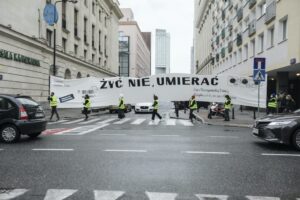
Letter Action © Monika Bryk
Ten days after the action, participants informed the public that two of them had each received a 10.000 zlotys fine from the specialized sanitary institution commonly known as “sanepid.” Fines were delivered by masked police officers. The action had been realized in lege artis with current regulations: with appropriate distance, facial covers and statement from the foundation commissioning the happening clearly proving artists had been performing their work. A crowdfunding campaign was quickly established to cover the penalties. Upon the intervention by Adam Bodnar, a celebrated ombudsman and civic society defender, fines were called off. Bodnar, among other arguments, pointed to a constitutional right to organize gatherings, and specifically to the role of government in delineating alternative ways for citizens to manifest their views, despite the pandemic regulations banning them in every form.
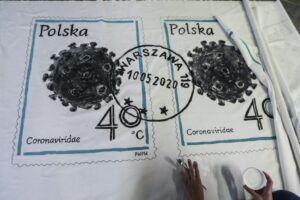
Letter Action © Monika Bryk
The ingenuity of the action, its timing, and public reception remind me of the significant book Agoraphilia by Piotr Piotrowski, which problematizes the nexus of art, democracy, and public space in post-communist Europe. In the introduction, the art historian offers a rather different understanding of the titular term from the one commonly known. “Agoraphilia is the drive to enter a public space, the will to participate in that space, to shape public life, to act and design for and in a social area.” I can identify this drive in the “Letter Action” as well as in the spirit of other acts of creative disobedience in public space in Poland that I am going to mention in the following paragraphs.
CITIZEN ARREST
Fast forward to the aftermath of the presidential elections won by Andrzej Duda who infamously said in his campaign that LGBT stands for an ideology and not for people. The dehumanization of queer people and structural homophobia has reached a new plateau. Besides, Poland is becoming internationally known for its hateful “LGBT-free zones” thanks to the unstoppable LGBT+ activist Bart Staszewski. Word has it that a new wave of migration is taking place since Duda’s reelection, a “migration after dignity,” in other words, an exodus of non-heteronormative people to the Western countries of the EU.
Second visit, end of July 2020. The pandemic has eased up and I am able to visit for a short holiday. It takes a few days for my body to relax. Do I tend to internalize too much or perhaps to be queer in Poland means, for me, to be overly self-aware in terms of space? I reckon I’ve managed to unlearn this since living abroad. I spend the last few days in Warsaw. The unprecedented amount of rainbow flags in the city makes me question for a second where I am. Locals declare their solidarity by hanging from their windows a piece of fabric. It is a potent gesture: it pokes conservatives in the eye, it gives a sense of agency, it brings color to arguably unattractive facades, but it can also make your landlord, neighbors, or even complete strangers invade your flat or threaten you if you don’t take it down.
“I spend the last few days in Warsaw. The unprecedented amount of rainbow flags in the city makes me question for a second where I am.”
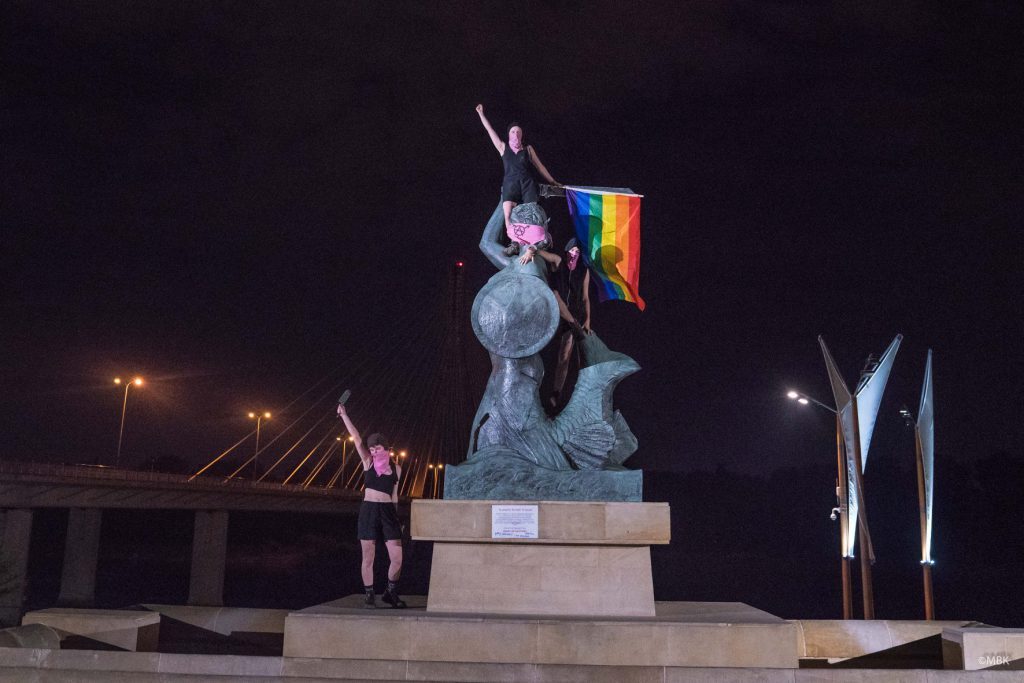
Stop Dzurbom © Spacerowiczka
It is a bit over a year since the violent attacks on the Equality March in Białystok, which is occasionally dubbed the “Polish Stonewall.” The queer collective “Stop Bzdurom” (Stop the bullshit) is becoming known for their situationist-like happenings and actions, such as covering statues and monuments with rainbow flags overnight and halting a homophobic truck, one that circles around the city equipped with speakers sound bombing everyone with hate speech. In the coming months on the premise of a “citizen’s arrest” this and another anti-choice truck, one that emits the cries of unborn children (!), will be repeatedly stopped by inhabitants of Warsaw.
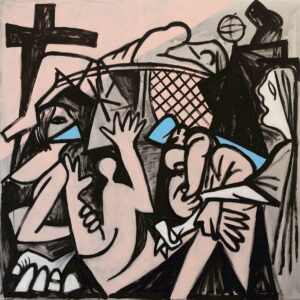
Detention of Margot. Karol Radziszewski.
On 7th August, police are about to seize Margot, a non-binary member of the collective who takes shelter in the offices of Campaign Against Homophobia (KPH). A spontaneous protest of LGBTQ+ people and allies in their defense is met with a shocking scale of police brutality. I text a lover that I’ve landed in the Netherlands, and he replies that he was just released from the police station all bruised up. Margot is facing two months of cautionary imprisonment, hideous misgendering, and hindrance of access to lawyers. A nationwide debate on gender-neutral pronouns is now about to unfold.
PUBLIC SPACE AS A SYMBOLIC BATTLEFIELD
Third visit, October and November 2020. I am headed for a month-long residency to browse archives and build a discursive program on the HIV epidemic, feeling motivated to work despite limitations posed by the coronavirus. A second wave seems inevitable, and so is the protest for the sake of reproductive rights in Poland after the government’s decision to vote in favor of harsh new regulations[5]The Constitutional Tribunal, consisting mainly of judges appointed by the ruling party Law and Justice (PiS), declared the law authorizing abortions for malformed fetuses to be unconstitutional, … Continue reading. On the eve of federal voting, I am watching the pre-premiere show of Polish rendition of The End of Eddy directed by Anna Smolar in STUDIO theatre gallery, located in the Stalinist Palace of Culture and Science. There is no need to insert Polish context into Édouard Louis’ work, it is more than enough to let the history of the old and the new name be told. For the applause, actors come out with lightning bolts. It is clear that a far more important performance is taking place on the streets as they bow down, and up, and down. This is where we’ll all meet. Nevertheless, this post-performance interaction reminds us that theatre can function as a kind of a communicating vessel with and to the public space, allowing for a mutual strengthening of both.
“It is a time of performative activism fueled by urgency and provoked by political pressure that cannot go unanswered.”
Even if during these past, long months of pandemic and protests a facade has started to crumble profoundly, the core of patriarchal, authoritative culture is still strong and well-supplied economically. Recent protests have begun to test these culture gatekeepers by clearly and loudly addressing a ‘get the fuck out!’ message to the police, the church, and the state with its phony justice system. It is a time of performative activism fueled by urgency and provoked by political pressure that cannot go unanswered. Some of the actions push the imagined boundaries of where contestation could take place. People are entering churches and cathedrals, activists changing roundabout names, showing up at the gates of key politicians’ homes and organizing performances in their proximity – as I am writing these words, the house of Jarosław Kaczyński, leader of the Law and Justice Party, is currently blurred out on Google Street View. The digital realm, too, has shifted to accommodate the energy of the protests, bursting with images of trans-parents, videos and to sustain growing on-platform activism.
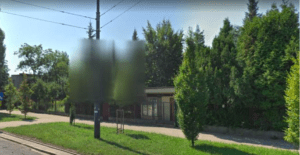
© Google street view
Public space during the pandemic has become a symbolic battlefield where artists fight with slogans written on cardboard against anti-abortion laws party gluing huge anti-abortion laws. Lightning bolts painted over the walls, bus stops, and city trash bins will eventually fade away and there will be time to cover them again. Undoubtedly, the protests over reproductive rights and a new generation of queer activism influenced the public debate in Poland and attracted worldwide attention. I trust that what has been happening in the streets continues in homes, bedrooms, and stretches to private and public chat rooms. Hopefully, the field of culture is where accountability and wise use of resources may prove exemplary in a broader sense, and I wish for it to learn from activists, community organizers, and care practitioners. I think it is safe to say that artists want to flourish, inspire their communities, and will continue to do so, even or maybe especially if their practice will be marked by a sense of civic duty. And this is what I see the fourth time I visit Poland since the pandemic started.
This article was originally published on Etcetera on June 18, 2021, and has been reposted with permission. To read the original article, click here.
This post was written by the author in their personal capacity.The opinions expressed in this article are the author’s own and do not reflect the view of The Theatre Times, their staff or collaborators.
This post was written by Szymon Adamczak.
The views expressed here belong to the author and do not necessarily reflect our views and opinions.
Notes
| ↑1 | In 1993 access to legal abortion became limited despite mass protests and against the women rights organizations. |
|---|---|
| ↑2 | Numerous students faced consequences from teachers and principals of their schools for presenting the lightning bolt during virtual classes. |
| ↑3 | Read more: https://culture.pl/en/work/the-letter-tadeusz-kantor |
| ↑4 | “Żyć nie umierać”. |
| ↑5 | The Constitutional Tribunal, consisting mainly of judges appointed by the ruling party Law and Justice (PiS), declared the law authorizing abortions for malformed fetuses to be unconstitutional, effectively banning most of the small number of official abortions carried out in Poland. |

